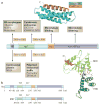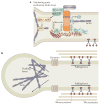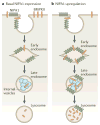Hereditary spastic paraplegias: membrane traffic and the motor pathway
- PMID: 21139634
- PMCID: PMC5584382
- DOI: 10.1038/nrn2946
Hereditary spastic paraplegias: membrane traffic and the motor pathway
Erratum in
- Nat Rev Neurosci. 2011 Feb;12(2):118
Abstract
Voluntary movement is a fundamental way in which animals respond to, and interact with, their environment. In mammals, the main CNS pathway controlling voluntary movement is the corticospinal tract, which encompasses connections between the cerebral motor cortex and the spinal cord. Hereditary spastic paraplegias (HSPs) are a group of genetic disorders that lead to a length-dependent, distal axonopathy of fibres of the corticospinal tract, causing lower limb spasticity and weakness. Recent work aimed at elucidating the molecular cell biology underlying the HSPs has revealed the importance of basic cellular processes — especially membrane trafficking and organelle morphogenesis and distribution— in axonal maintenance and degeneration.
Conflict of interest statement
The authors declare no competing financial interests.
Figures




References
-
- Harding AE. The Hereditary Ataxias and Related Disorders. Churchill Livingston; Edinburgh: 1984.
-
- DeLuca GC, Ebers GC, Esiri MM. Axonal loss in multiple sclerosis: a pathological survey of the corticospinal and sensory tracts. Brain. 2004;127:1009–1018. - PubMed
-
- Fischer LR, et al. Amyotrophic lateral sclerosis is a distal axonopathy: evidence in mice and man. Exp Neurol. 2004;185:232–240. - PubMed
-
- Harding AE. Hereditary spastic paraplegias. Semin Neurol. 1993;13:333–336. - PubMed
Publication types
MeSH terms
Grants and funding
LinkOut - more resources
Full Text Sources
Other Literature Sources
Molecular Biology Databases

